Bentley Systems
Affordable Bentley software bundled with customizable training and support

MOSES CONNECT Edition
Conquer the complexity of marine operations with simulation

SACS Collapse View
Identify failure mechanisms from a range of dynamic events

SACS Offshore Structure
Improve offshore structure design, analysis, safety, and reliability

SACS Pile Structure Design
Reduce risk of failure for offshore structure foundations

SACS Fatigue Ultimate
Design for safety and reduce offshore failure risks
The Preferred Finite Element Program for Linear and Nonlinear Structural Analysis
ADINA Structures provides state-of-the-art stress capabilities for the analysis of solids and structures. The analysis can be linear or highly nonlinear, static or dynamic, and may include geometric nonlinearities, large deformations, severe material nonlinearities, load nonlinearities, and contact conditions.
ADINA Structures offers versatile and generally applicable finite elements for solids, shells, beams, trusses, pipes, and special purpose applications. Material models for metals, soils and rocks, plastics, rubber, fabrics, wood, ceramics and concrete are available.
ADINA Structures was developed to solve the most difficult nonlinear problems in diverse engineering disciplines. Continuous feedback from our customers for over 30 years has strengthened and enhanced the features offered in ADINA.
ADINA Structures may be used as a standalone program for structural-only analyses, or it may be used in conjunction with other modules in the ADINA product suite for multiphysics applications, such as thermo-mechanical coupling or fluid-structure interaction analyses.
Linear Analysis
Linear analysis applies to problems that meet linear assumptions: materially linear problems with small displacements, small deformations, and constant boundary conditions. If any of the above assumptions are not satisfied, a nonlinear analysis must be performed.
ADINA Structures offers powerful solvers and element formulations allowing the solution of extremely large models with minimal CPU time and memory requirements.
Nonlinear Analysis
ADINA Structures is the premier finite element program for nonlinear analysis used to solve the most difficult nonlinear problems in industry and academia involving geometric nonlinearities, large deformations, material nonlinearities, load nonlinearities, and contact conditions.
ADINA Structures has unique solution capabilities for nonlinear analysis providing great stability and reliability, thereby allowing the program to solve problems that cannot be solved using other commercial finite element programs.
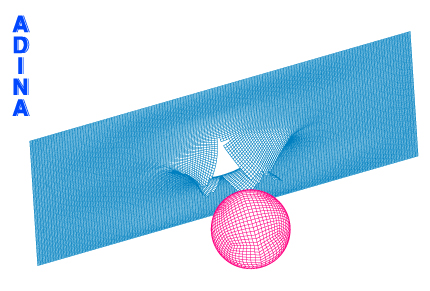
Steel ball impacting and punching through a thin plate
Related Content
Elements
ADINA Structures offers solid elements (2-D and 3-D solid elements), structural elements (truss, beam, pipe, shell, spring, optimal shell elements, MITC3+ and MITC4+), fluid elements (2D and 3D potential-based subsonic fluid elements), acoustic elements, and special purpose elements (alignment, connector, general). The same element can be used in both linear and nonlinear analysis. For example, the shell elements can be effectively used in the analysis of thick and thin shells, under linear and nonlinear conditions. User-defined elements can may also be implemented.
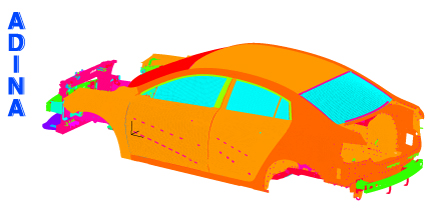
Automobile mesh consisting of continuum and structural elements
Related Content
Material Models
ADINA Structures offers a rich library of material models for soils and rocks, plastics, rubbers, foams, fabrics, wood, ceramics, porous-media, and concrete. User-defined materials can also be implemented.
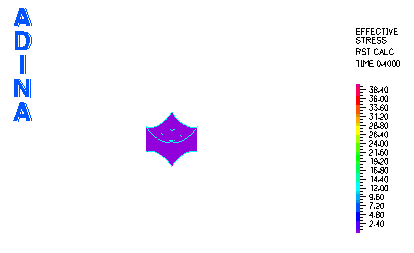
Stretching of a rubber component using the Mooney-Rivlin material model
Related Content
Contact Analysis
ADINA Structures provides a variety of advanced contact algorithms for general contact conditions including frictionless and frictional contact, small sliding and large sliding contact, single-sided and double-sided contact, and self-contact. Coulomb-type and general friction models are supported.
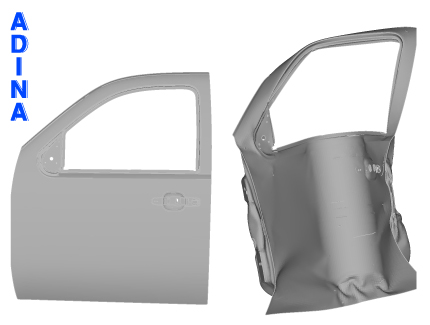
Crushing of an automobile door using self-contact analysis
Related Content
Dynamic Analysis
ADINA Structures offers implicit dynamic analysis, explicit dynamic analysis, and mode superposition time integration schemes.
A unique capability of ADINA Structures is the Bathe method for implicit dynamic analysis. The Bathe method accurately integrates the low frequency modes that can be spatially resolved and automatically cuts-out the spurious high-frequencies that lead to chatter and noise. This approach results in remarkably stable and accurate solutions for linear and nonlinear dynamic analysis.
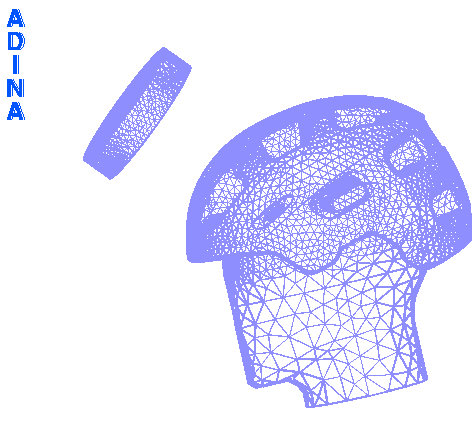
Impact test of bicycle helmet
Related Content
Frequency Analysis
ADINA Structures can be used to compute frequencies and mode shapes in linear and nonlinear analysis. The frequencies computed for nonlinear analysis may include the effect of geometric nonlinearities, material nonlinearities, bolt loading, mesh glue, and contact conditions. The frequencies can be automatically computed at any solution time during a linear or nonlinear analysis in statics or dynamics.
ADINA Structures also offers frequency domain analysis capabilities including response spectrum analysis, Fourier analysis, harmonic vibration analysis, and random vibration analysis.
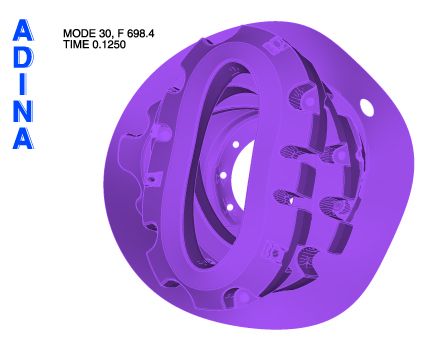
Mode frequency analysis of a car wheel
Related Content
Buckling and Post-buckling Analysis
ADINA Structures offers a wide range of analysis capabilities for the buckling and post-buckling response of solids and structures including the possibility of introducing small geometry imperfections prior to analysis. ADINA Structures also offers specialized elements for large strain bending of shells that can be used to accurately predict the post-buckling response of thin structures.
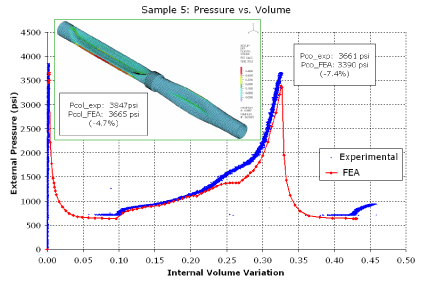
Collapse of Underwater Pipe
Related Content
Other Capabilities
ADINA Structures provides many additional capabilities for structural analysis including:
- Mesh glue to join dissimilar meshes.
- Bolt feature to model bolt tightening and bolt shortening in linear and nonlinear analysis. 3D-bolts and beam-bolts are supported. Bolt tightening sequences (bolt tables) can also be modeled.
- Element birth and death, and element death upon rupture to model processes in which material is added and/or removed from the structure, or to model material failure.
- Analysis zoom to analyze a detailed model of a local area of interest within a structure from the results of a coarse model of the entire structure in linear and nonlinear, static and dynamic analysis.
- Cyclic symmetry and periodic symmetry analysis for components where the geometry and boundary conditions are rotationally symmetric. It can be applied to static, dynamic and frequency analyses. The memory required for cyclic symmetry analysis is typically an order of magnitude less than that required for the full analysis, and the solution time can also be an order of magnitude smaller.
- Restart analysis to continue an analysis beyond its previous end point, or to change the analysis type, loads or boundary conditions or tolerances. It supports restarting from static to dynamic analyses as well as switching between implicit and explicit dynamics.
- Analysis switch to automatically switch the analysis type at any solution time. All analysis types are supported including static, dynamic, frequency, and modal participation factor analysis. For example, the switch can be from static to dynamic analysis, from implicit dynamic to explicit dynamic analysis, or a frequency analysis can be performed at any solution time during a nonlinear static or dynamic analysis.
- 3D-iterative solver to efficiently solve large models containing mainly higher-order elements in linear and nonlinear analyses, including contact.
- Fracture mechanics to compute the J-integral and stress intensity factors including the calculation of mixed-mode stress intensity factors. One or more cracks can be included in the model. Linear and nonlinear fracture mechanics can be performed on mapped or fully free-formed meshes around the crack front.
- Initial stresses/strains for all element types in linear and nonlinear analysis.
- Model reduction schemes such as substructuring, component mode synthesis, and general elements.
- And many more:

Bolt model
Related Content
- Dissimilar mesh glueing
- Constraint equations
- Rigid links
- Cyclic symmetry analysis
- 3D-iterative solver
- Modeling Bolted Structures
- The 3D-bolt
- Stability Analysis of Tunnels
- Simulation of a Cutting Process
- Seamless Implicit-Explicit Dynamic Analysis
- Modeling Fracture
- Substructuring with Local Nonlinearities
- Substructuring in Dynamic Analysis
- Component Mode Synthesis
- Component Mode Synthesis and the Bathe Subspace Iteration Method
- Initial Membrane Stresses on Mode Shapes of Shells
Advanced Support
Receive advanced support from engineers that use Bentley Systems every day.
Our standard support is included when you purchase a product license or subscription (active maintenance):
- Licensing and setup questions
- Basic technical questions about software features and building models
- Simple troubleshooting.
- Detailed help building complex models (even production simulations)
- Extensive troubleshooting, debugging, and testing of models
- Custom consulting projects.
Advanced support isn’t included with active maintenance.
Meet Dr. David Cross, one of our expert engineers

Feature 1
Feature description
Feature 2
Feature description
Feature 3
Feature description



